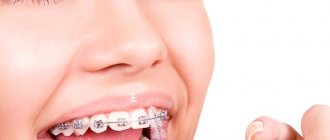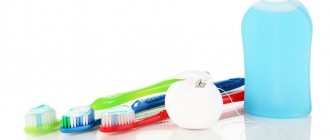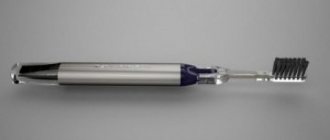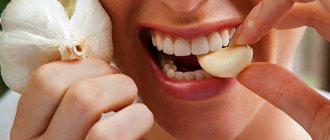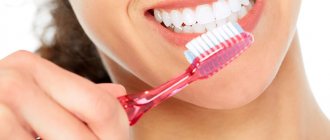You can remember the times when our ancestors used roots, crushed eggshells, pumice, and ash instead of toothpaste. But progress is developing in all directions. Gradually, toothpaste appeared on store shelves. Now you can go to any supermarket and buy any toothpaste.
Many people don't even bother with the choice. Some people buy pasta based on their budget, others prefer well-known brands. But few people look at the composition itself, and in principle know everything about toothpaste. On the website elgreloo.com you can find out the whole truth about toothpastes and decide which toothpaste is right for you. You will also learn:
- The history of the creation of toothpaste
- Types and classifications of pastes
- Ingredients of toothpastes: natural, whitening, children's
- How is toothpaste made?
- Choosing the right toothpaste
- Homemade toothpaste recipe
The history of toothpaste
In the 18th century, tooth powder appeared in Great Britain. Rich people applied tooth powder to a special brush and cleaned their teeth this way; poorer people did it with their fingers. Even though these two products were developed by dentists and chemists, they were harmful to teeth. Already in the 19th century, the purpose of tooth powder was not only to clean teeth from plaque, but also to give fresh breath.
Regular production of toothpaste began in the 70s of the 19th century in America. In 1873, Colgate introduced flavored toothpaste in a jar. After several decades, the tube was invented. Since then, production has developed. Somewhere from 1915, plant extracts began to be added to the paste, and from the 50s of the 20th century, fluoride was added to the paste as protection against caries.
THE WHOLE TRUTH ABOUT TOOTH PASTE! FOODS FOR CONSIDERATION
How often do you brush your teeth and how many times a day? Once, twice, most likely. Have you ever wondered what your toothpaste consists of, what substances are there? After all, you practically use it all your life! Probably, just like me, you were indifferent to this and simply trusted the “Dental Association”.
Cox began researching fluorine at the suggestion of the director of the research laboratory, Francis Frerey, which belonged to the American Aluminum Company.
Not long ago, after reading information about the dangers of fluoride, I couldn’t help but think about it. After all, before I could never even admit the idea that the toothpaste that I have been using throughout my entire adult life could contain components that are dangerous to the human body. All these commercials for toothpastes that flash before our eyes simply irritated me with their importunity, nothing more.
To my surprise, after a short search on the Internet, I found so much “interesting” information about fluoride, as well as the effects of this substance on the body, that after some reflection on everything I had read, I was shocked.
This article will give you some food for thought.
What are fluorine and fluoride?
Fluoride is the fluoride ion. All inorganic and organic compounds containing fluorine are fluorides. These are exactly what will be discussed in this article.
Fluorine is a gas. In nature, it is present most of all in combination with other substances. An example is calcium fluoride (CaF), or sodium fluoride (NaF).
Fluoride is a natural element that is part of the earth's crust. Not a very large proportion of fluoride (less than 1 ppm) is present in water. Plants, absorbing fluoride from the soil and water, saturate our food and water with it, and in the same way accumulate fluoride in animal tissues and plants.
Fluoride is toxic to humans, despite the fact that it is a natural substance. Moreover, it is much more toxic than lead!
An injection of 2-5 grams of sodium fluoride (a standard ingredient in toothpaste) is fatal to humans.
A medium-sized tube of toothpaste contains enough florida to kill a small child if you use the entire tube at once!
Fluoride toothpastes contain a higher concentration of fluoride than what occurs naturally.
In the beginning, fluoride was added to water because it was believed that it prevented tooth decay and was very good for teeth. Later and into toothpaste. There are countries, such as the USA, where almost 2/3 of all natural water is fluoridated.
So how does fluoride work in the fight against tooth decay?
Fluorine has been found to be toxic to bacteria. The bacterium, like other living forms, also feeds on sugar, for example (glucose, sucrose, fructose, lactose or food starches), as well as bacterial waste. These wastes are the very acids that can dissolve tooth enamel and cause caries. Fluorine is a poison for bacteria, and as a result of its influence, a decrease in the ability of bacteria to process sugar.
But unfortunately, fluoride is so poisonous that it poisons not only bacteria, but also other cells in the body.
Risks of Fluoride Use
Even when consumed in small doses (in fluoridated water or toothpaste), fluoride can cause serious problems to your health.
Chronic fluoride intoxication - Fluorosis, occurs in two forms: dental and skeletal, with terrible symptoms that are best not described.
There are also numerous animal studies that say that fluoride is also a neurotoxin that reduces cognitive abilities (language learning, speech, thoughts) and memory.
There are also numerous health problems associated with fluoride consumption.
Basic information that was previously strictly classified has only been made public in the last 10 years.
What does your toothpaste consist of: food for thought
Now the bitter truth
So why did people start adding fluoride to their water and toothpaste?
As you might expect, politics and money are involved.
Renowned BBC producer and journalist Christopher Bryson's book, Fluoride - The Big Deception, after 10 years of fact-finding, describes the origins of the myth about the benefits of fluoride. This book highlights the scientific institutions and specific famous individuals who played a major role in the use of fluoride to prevent dental disease throughout the world today.
"Experts" who defend the fluoridation theory argue that there are two different issues regarding fluoride, and they do not overlap with each other.
The first is that fluorides are industrial waste from metal production, and the second is that fluoride is useful for dental hygiene.
This is a lie, since these storylines are tightly intertwined from the very beginning.
A little history
The first statements that fluoride is good for teeth, as well as that it should be added to drinking water to prevent dental disease, were made by a certain doctor - Gerald Cox (Melon Institute, Pittsburgh, Canada)
Francis Freri, in turn, was very concerned about the negative impact of fluorides on the health of plant workers, as well as the pollution of the air and nature in the vicinity of the aluminum smelters.
It should be noted that the Melon Institute was the main defender of the metal processing industry and, of course, for all its large companies. It is no coincidence that it was from the researchers of this institute that this proposal came.
At that time, from the mid-50s to the mid-60s, there were so many lawsuits related to health harm caused by fluoride alone (than 20 other pollutants combined) that companies urgently needed protection from the enormous amount lawsuits. And a solution to the problem was found. A theory was invented that was supposedly based on actual research that fluoride was good for your health!
One of the defenders of the theory of fluoridation was one of the most influential and famous physicians, with unquestionable authority among those in power - Harold Hodge. Hodge was responsible for numerous works in support of the water fluoridation program and its implementation by 1957.
Today it became known that it was Hodge who was one of the organizers of research and experiments on the effects of radiation on human health after inoculation with plutonium.
So what's the connection?
The most direct one. Harold Hodge served as chief toxicologist on the Manhattan Project.
The project was launched with the goal of developing an atomic bomb, which was subsequently dropped on Jeroshima and Nagasaki. Hodge conducted research on the toxicity of various chemical reagents that were components of the atomic bomb, and the main problem was precisely fluorides; they were used in incredible quantities in the creation of atomic weapons.
In the discovered documents, the book's author, Bryson, saw records that Hodge was given an assignment to provide information to help the government and army defend against lawsuits that were related to personal injury. All information used against the army must be destroyed.
If the dangers of water fluoridation were recognized, then absolutely all organizations that worked with fluoride would be subject to countless lawsuits. Even the US government and military, including the Nuclear Energy Commission. Naturally, Harold Hodge would in no way frame these influential organizations.
Dr. Keyhoe, a well-known physician and promoter of the theory of fluoridation, has published large scientific works on the benefits of fluorides.
These works were sponsored by:
MORE ARTICLES ON THE TOPIC SHOT IN THE NECK: WHAT TO DO?
Aluminum Company of America (ALCOA), Aluminum Company of Canada, DuPont, Fuel and Lubricants Research Institute of America, Reynolds Metals, United Steel, Kaiser Aluminum, National Institute of Dental Research (NIDR).
In Dr. Keyhoe's personal notes, you can find information about cooperation with the Fluoride Legality Committee, to which Dr. Keyhoe provided materials to defend against fluoride-related lawsuits from corporate clients (see list above).
In addition, none other than Sigmund Freud’s nephew, PR’s father, Edward Bernays, helped sell fluorides to the entire nation.
Edward Bernays was a true professional in the field of creating attractive images for harmful products. Edward was a good psychologist, and conducted research on managing the human mind, and more precisely, managing society. He even published the book “Propaganda”.
While promoting fluoridation, Bernays also took part in promoting cigarettes. Invited to NIIOS to help promote fluoride to the nation, Bernays worked to convince dentists that fluoride was good for teeth. Then the already treated dentists themselves “sold” fluoride to everyone else.
For decades, propaganda in favor of fluoride has been carried out among the population. Scientists who openly stated that fluoride was harmful to the human body were persecuted, ridiculed in the press, or fired from their jobs.
Only today scientists have the opportunity to publish research results that talk about the dangers of fluoride, even in doses allowed by standards.
Widely advertised toothpastes (“Blend-a-med”, “Colgate”, “Aquafresh”, etc.) contain fluoride in fairly large quantities. People buy these toothpastes because of repeated lies in advertising.
So what should we do now?
First, look at this issue with different eyes. Following common sense, we must understand that we should not take (especially regularly) any substances if we do not understand what the substance is.
Even if slight doubts creep in that fluoride can be harmful, it means there is no point in using it. In our case, numerous materials convince us that it is better to abandon it.
Tips from dentists for “fluoride-free” caries prevention: The less often we eat foods rich in white sugar, the less acid bacteria will produce. It is advisable to consume sugar only in whole foods - nuts, fruits, dried fruits. Even more harmful than white sugar is a genetically modified sweetener (aspartame). Reduce the amount of time sugar remains in your mouth. After eating a meal rich in sugar, you should brush your teeth or rinse your mouth. It is also harmful to suck sweets in the mouth and drink sugary drinks for a long time. If you drink sweet water, you should immediately brush your teeth. It is necessary to brush your teeth thoroughly and often, both with floss and a brush.
Additional Information:
Countries that have banned water fluoridation:
Germany, Austria, Switzerland, Holland, France, Belgium, China, Czech Republic, Denmark, Finland, Hungary, India, Israel, Japan, Luxembourg, Norway, Scotland, North. Ireland, Sweden.
The pineal gland is the first to be hit by fluoride.
It was not until the early 1990s that research began to be conducted on the effects of fluoride on the pineal gland. The pineal gland, or pineal gland, is a small gland that is located between the two hemispheres of the brain.
The pineal gland regulates the release of melatonin, the “youth” hormone, which in turn helps regulate the achievement of puberty. Melatonin is produced by the pineal gland from serotonin, a substance that scientists suggest affects human mental function.
It is also very important that the pineal gland is responsible for immunity, and when it functions normally, it protects the body from the harmful effects of free radicals on the brain.
The initiator of this study, doctor Jennifer Luke (University of Surrey in England), proved that the pineal gland is the first to be affected by fluoride. According to research, excessive amounts of this element in the pineal gland lead to serious dysfunctions and provoke early puberty, and the body’s ability to fight free radicals also decreases.
Research shows the dangerous effects of fluoride on the fetus during pregnancy. Fluoride can cause genetic changes in the fetus, thereby increasing the risk of cancer. Recent studies have shown that fluoride can cause bone cancer.
The worst thing is that almost no one pays attention to these facts. Think about what would happen to the industry if everyone knew about the toxicity of fluoride and its harmful effects on our health!
Fluoride compounds have the most significant effect on the thyroid gland
Research data from scientists shows that thyroid diseases began to increase just at the time when the benefits of fluoride began to be promoted. It is known that the thyroid gland in the body is responsible for many processes related to metabolism.
Subscribe to our website on INSTAGRAM
Violation of its work leads to serious consequences for a person, one of which is obesity. It is no coincidence that the popularization of fluoride in the United States has led to the country's population becoming fatter. Scientists have tracked the relationship between these processes.
Excess fluoride in the body can destroy bones, teeth and the pineal gland
Long-term use of fluoride can lead to genetic damage to DNA, cancer, obesity, low IQ, lethargy, Alzheimer's disease and many other diseases.
Almost all toothpastes contain fluoride. Since childhood, it has been drilled into our memory that we need to brush our teeth twice a day.
The effect of fluoride on the thyroid gland is not all.
Fluorine, actively reacting with aluminum, which is widely used in the manufacture of tableware, forms aluminum fluoride, which can overcome the blood-brain barrier.
The blood-brain barrier protects our brain from harmful substances. Aluminum fluoride penetrates through it and is deposited in nerve cells. The consequences of this compound for the brain can be catastrophic.
This includes dementia and a number of mental and nervous disorders. Studies by some independent scientists have shown that cases of Alzheimer's disease have increased significantly since the popularization of fluoride. Therefore, it is not surprising that the United States is one of the leaders in the incidence of Alzheimer's disease, since fluoridation is used especially widely in this country.
From the Chemicals Handbook:
Sodium fluoride is a synthetic component in the form of white crystals. It is used as an antibacterial agent for oral care. The active part of the molecule is the fluoride ion. Fluoride reduces the bacteria's ability to produce acid, and it also remineralizes the area of the teeth that have been exposed to the acid produced by the bacteria. ABOUT.
May be fatal if inhaled or if swallowed. The main symptoms of poisoning are diarrhea and weakness, nausea, vomiting. Next comes damage to the cardiovascular and central nervous systems, which leads to death.
It also affects the kidneys, respiratory system, central nervous system, heart, bones, and circulatory system. Causes irritation to eyes, respiratory tract and skin. Irritation does not occur immediately.
Causes severe irritation to the respiratory tract if inhaled. The first symptoms are difficulty breathing, cough, sore throat.
Toxic if taken orally! Causes stomach pain, nausea, vomiting, diarrhea and drooling. Difficulty breathing, weakness, trembling, heart attack, then convulsions and coma. It affects the kidneys and brain. Death occurs due to paralysis of the respiratory tract. The lethal dose is about 5-10 grams.
Causes irritation upon contact with skin, pain and redness.
In case of eye contact, ranges from irritation to serious eye damage.
Long-term exposure to fluoride can damage bones (osteosclerosis), as well as fluorosis. Fluorosis leads to bone fragility, weight loss, anemia, hardening (calcification) of ligaments, deterioration of general condition and joint stiffness.
People with diabetes and kidney failure are especially susceptible to the effects of fluoride.
What does your toothpaste consist of: food for thought
MORE ARTICLES ON THE TOPIC: 40 MOVIES THAT INCREASE WOMEN'S SELF-ESTEEM
So why is excess fluoride dangerous?
The addition of fluoride to municipal waters, as well as other methods of its use, cause concern among people.
In a number of countries (not Russia), synthetic fluoride compounds are added to water and also used in drinks, hygiene and food products, for example, toothpastes.
The most commonly used waste products from the nuclear, aluminum and phosphate (approval) industries are:
(sodium silicofluoride) - sodium fluorosilicate
(sodium fluoride) - sodium fluoride
(fluorosilicate acid) - fluorosilicic acid
Fluoride is not quickly eliminated from the body; it accumulates in bones and teeth over time.
Recently it became known that it accumulates even more intensely in the pineal gland, which is located in the middle of the brain.
Dental fluorosis, causing serious damage to teeth, with daily use of fluoride toothpastes has already been documented.
Despite this, today there is official propaganda about the use of fluoride for the prevention of caries. The fact that fluoride does more harm than good continues to be ignored.
The following health problems are associated with long-term and daily use of fluoride in the form of sodium fluoride:
- genetic disorders at the DNA level - cancer - dysfunction of the thyroid gland, with consequences for the entire endocrine system - Alzheimer's disease; — neurology: inability to focus, fatigue, decreased IQ; - a disturbance in the activity of the pineal gland hormone, which reduces anti-cancer protection, sleep disturbance; - blockage of the pineal gland and its calcification.
It is important to remember that boiling water only increases the fluoride content in it!
Reverse osmosis technology (reverse osmosis) works great for purifying water from fluoride and is quite accessible. Special devices for water purification using this technology can be found in stores.
Lies in beautiful packaging
Increasingly, scientists are declaring that one of humanity's biggest lies is fluoridation.
Water saturated with fluoride, toothpastes - we think that all this is useful, and by enriching tooth enamel with fluoride, we keep our teeth healthy and beautiful. For several decades, leading scientists have been promoting the benefits of fluoride toothpastes and water fluoridation.
This situation is also relevant for today, however, today, more and more famous scientists refuse to lie and tell us about the actual state of affairs.
Huge concerns have long realized that one of the best ways to get rid of production waste is to sell it to us so that we can consume this crap.
The most egregious global crime of this kind is the fluoridation programs in water and toothpastes in the West.
When the production of atomic bombs was launched, as part of the Manhattan Project, toxic fluorides began to accumulate in huge quantities in landfills. DuPont's landfills in New Jersey have accumulated so much toxic fluoride that they are washed away by rain and begin to seep into the soil.
Pets in the area began to die, all the plants withered, as a result of which indignant residents filed a lawsuit against the company.
With the task of finding some kind of “medicinal use” for fluorides, the DuPont concern hired famous lawyers and doctors. As a result, a fake appeared and began to be replicated everywhere that fluoride strengthens teeth. As a result, the DuPont concern not only avoided trial, but also received an excellent opportunity, in the future, to get rid of toxic waste by selling it to us.
All over the world, billions of people drink and eat, with water and toothpaste, all this poison. Fluoride has never strengthened anyone's teeth.
Here is a list of the toxic effects of sodium fluoride, which is used to chlorinate water and toothpastes. Most water fluoridation stations use aluminum sulfate and fluorides together. These two substances mix to form toxic Aluminum Fluoride.
Aluminum is a foreign element for living organisms. It is practically not excreted from the body, is toxic to the kidneys, and when accumulated in the brain causes Alzheimer's disease.
Drinking water with fluoride or from toothpaste is deposited in the human body and is concentrated, as a rule, in places where calcium accumulates, i.e. in bones and teeth.
About 20-40 mg. fluoride per day suppresses the activity of the most important enzyme - phosphatase, which is necessary for calcium metabolism. As a result, the bones thicken, but become brittle and brittle.
In the early 1980s, fluoride was discovered to stimulate bone growth, although it could cause bone deformities, such as heel spurs.
Some studies have linked increased hip fracture rates to fluoride intake.
Some scientists suggest that fluorides are carcinogens.
In 1988, the Agonna National Laboratory (USA) published a study claiming that fluoride turns normal cells into cancer cells. In turn, Japanese doctor Tsutsui confirmed that under the influence of fluoride, normal cells not only turn into cancer cells, but also lead to genetic damage to cells, which suggests that it is harmful to pregnant women.
Even government studies in the United States itself, after analyzing 156 cases of cancer deaths, led to the conclusion that fluoride accumulated in tissues causes both cancer and other fatal diseases.
Research by the chief chemist at the US National Cancer Center, Dr. Dean Burke, showed that fluoride in toothpastes, as well as drinking fluoride, causes up to ten thousand deaths from cancer per year.
Other studies have shown a significant increase in the incidence of malignant bone tumors in children (osteosarcoma) where the population drinks fluoridated water.
Studies have shown that genetic damage occurs even at half the concentration of fluoride contained in drinking water.
In his book, Dr. Yamoyannis (Japan) argues that fluoride damages the human immune system, in other words, it contributes to the occurrence of AIDS. Yamoyannis also writes that the human enzyme system inhibited by fluorides leads to premature aging due to the complete destruction of collagen. There is also evidence linking fluoride to infertility.
So which toothpaste should you choose?
Brushing your teeth with toothpaste is one of the important hygiene rules taught to our children at an early age. But which healthy natural toothpastes are still worth buying, without the choice imposed by advertising?
It is necessary to study information about the quality and composition of the ingredients that are included in the toothpaste.
First of all, you need to make sure - is the toothpaste with fluoride or without it? Most studies show that neither fluoride toothpastes nor fluoridated water have any effect on dental health.
People consume enormous amounts of fluoride every day from numerous sources. After all, fluoride is found not only in toothpaste, but also in drinks, juices, water, and in most products prepared with fluoridated water.
Dental fluorosis, fluoride poisoning, leads to softening of tooth enamel. These symptoms are found in more than 60% of children.
Avoid toothpastes with fluoride.
Healthier than toothpaste with propolis, baking soda, tea tree oil, or myrrh.
In his book Fluoride as a Factor in Aging, Dr. J. Yamouyiannis writes:
"The truth is that fluoridation is poisoning millions of people around the world." Renowned biochemist, editor of the "Chemical Abstracts Service" at the famous chemical information center. After he began questioning the safety of fluoridation, he was told to remain silent because millions of dollars in federal investment were at risk. As a result, he was forced to resign.
A good toothpaste is a paste containing ultra-fine silicon dioxide powder, which perfectly removes stains from the surface of teeth without damaging the enamel and polishes teeth.
LIKED? SAVE TO YOUR PAGE BY CLICKING THE BUTTON
Classification and types of toothpastes
Toothpaste is the simplest and most affordable means of caring for teeth and gums. Types of pastes by purpose:
- Hygienic. They do not have any medicinal properties. They are simply designed to freshen breath and remove food debris between the teeth.
- Therapeutic and prophylactic. They prevent various diseases of the teeth and gums from appearing and developing.
- Therapeutic treatments deal with existing problems.
The last type of toothpaste is prescribed as a last resort. Usually you cannot buy such pastes in a regular store; they are prescribed by a doctor and sold by prescription. Most often, doctors recommend using a second type of toothpaste.
Classification of toothpastes by action:
- Strengthening;
- Healing;
- Preventing plaque and caries;
- Whitening;
- Deodorizing pastes fight bad breath;
- Reducing enamel sensitivity.
Quite often, people buy a complex product that works on everything, but a little at a time. They reduce the risk of serious illness, but do not completely solve the problem. On our website elgreloo.com you will now find out what different toothpastes consist of.
Composition[ | ]
Previously, only calcium carbonate was used as an abrasive in pastes. But this compound is not chemically inert and reacts with other components of the paste, for example, fluorine compounds. Therefore, at the moment, completely inert compounds are most often used as abrasives, for example: silicon dioxide, hydrated silicon dioxide, titanium dioxide, aerosil, aluminosilicate, dicalcium phosphate. It should be noted that in some toothpastes in the economy segment you can still find a combination of calcium carbonate with sodium fluoride or sodium monofluorophosphate. There are clinical studies that show that the combination of calcium and fluoride compounds in one tube of toothpaste leads to a subsequent decrease in the concentration of free fluoride ions (from 15 to 50% of the concentration of fluoride ions declared by the manufacturer).
Surfactants (surfactants) are responsible for foaming the paste. The most common are sodium lauryl sulfate and betaines. The introduction of a surfactant allows you to reduce microdamage to tooth enamel when brushing your teeth to a minimum. In addition, according to numerous sociological studies, most people are adherents of highly foaming toothpastes.
To form a homogeneous consistency, binders are used - agar preparations, pectin, dextran, glycerin, sodium alginate, sodium carboxymethylcellulose.
The active components of toothpastes are substances that can have a therapeutic and prophylactic effect - aluminum lactate, fluorides, compounds with antimicrobial activity, individual micro-, macroelements and polymineral complexes, extracts of medicinal herbs, enzymes, propolis, etc.
The anti-carious effect is ensured by the presence of fluorides (sodium fluoride, tin fluoride, amino fluoride, monofluorophosphate) or bioavailable calcium (calcium glycerophosphate) in toothpaste. The simultaneous addition of calcium and fluorides to the paste is ineffective, since they interact with each other, forming an insoluble salt - calcium fluoride. And also xylitol - a substance with a pronounced bacteriostatic effect against cariogenic microflora.
The anti-inflammatory effect is usually achieved by adding herbal extracts (mint, sage, chamomile, etc.) to toothpaste, sodium bicarbonate - soda, which causes a hypertonic effect in the tissues of the oral cavity, thereby reducing swelling, as well as a weakly expressed antibacterial effect.
Whitening pastes contain silicon hydroxide of a given degree of abrasiveness (RDA 100-200 for whitening toothpastes), as well as sodium or potassium pyrophosphate, which effectively dissolves soft dental plaque and pigments. Whitening pastes with RDA 100-120 can preferably be used for a course of 1 month (but not more than 2 months). Pastes with an RDA of 150-200 are designed to remove massive pigment plaque, and they can only be used 1-2 times a week. Regular hygienic toothpastes have an RDA of around 75.
Recently, pastes based on sorbents (polydimethylsiloxane, methylsilicic acid hydrogel) have been actively developed. The use of enterosgel in toothpastes allows one to obtain not only a mild abrasive effect, but also a pronounced sorption effect towards microorganisms and an enamel-protective effect. In addition, pastes with sorption action have the ability to absorb odors resulting from the activity of microorganisms (halitosis). [ source not specified 1873 days
]
Both natural and identical to natural compounds act as flavoring agents. Of the natural ones, the most commonly used aromatic components of essential oils (terpenoids) are menthol, thymol, carvacrol, limonene, squalene, etc. It should be borne in mind that many natural components of essential oils are allergens.[4] The use of synthetic flavors allows you to reduce the cost of the final product.
A number of innovative toothpastes also use a component such as ultrafine synthetic hydroxyapatite. It is closest in structure to natural hydroxyapatite of tooth enamel, and due to its small particle size (about 0.05 microns) it can be embedded in defects and microcracks in the enamel, as if “bricking” them. The most important factors ensuring the effectiveness of toothpastes with hydroxyapatite are the size of the hydroxyapatite particles, as well as its concentration. Unfortunately, almost none of the manufacturers disclose this data. It should also be noted that the anti-caries effectiveness of pastes with hydroxyapatite is significantly less than that of conventional fluoride toothpastes. This is due to the fact that although hydroxyapatite seals small microcracks in the enamel, it still does not make tooth enamel more resistant to lactic acid secreted by cariogenic bacteria.
In turn, the use of fluoride toothpastes leads to the transformation of hydroxyapatite of tooth enamel into fluorohydroxyapatite, which is much more resistant to acid. For example, the critical pH value, after which acid begins to dissolve tooth enamel hydroxyapatite with acid, is 5.5. In turn, for fluorohydroxyapatite, the critical pH value is 4.5 (that is, dissolution will be observed only at a significantly higher acid concentration).
Toothpastes also contain urea with components such as xylitol and sodium bicarbonate, which are therapeutic and prophylactic additives. This mixture neutralizes the action of acids, mainly lactic acid, which is produced by plaque bacteria by fermenting carbohydrates found in foods and drinks. Bacteria also produce, although in much smaller quantities, other acids, such as acetic, propionic and butyric. The formation of acids leads to a decrease in the pH of dental plaque: at a pH less than 5.5, the process of demineralization of tooth enamel begins. The longer the duration of such demineralization, the higher the risk of caries. Penetrating into dental plaque, urea neutralizes acids, being broken down by bacteria in the presence of the enzyme urease into CO 2 {\displaystyle CO_{2}} and NH 3 {\displaystyle NH_{3}}; the resulting NH 3 {\displaystyle NH_{3}} has an alkaline reaction and neutralizes acids.
Ingredients of toothpastes: natural, whitening, children's
The basic composition of toothpaste includes: glycerin base, chalk, water, perfume oil, fragrances, sodium salt of carboxymethylcellulose, which acts as a thickener, as well as sodium lauryl sulfate, so that the paste foams well. It is also necessary that the paste contains fluorine, calcium and phosphorus. The composition of natural toothpaste also includes:
- Liquorice or licorice extract. This component has anti-inflammatory properties.
- Xylitol has an antifungal effect.
- Bromelain protects enamel from bacteria.
- Laminaria has anti-edematous properties.
Parents should remember that children's teeth are more delicate and require special toothpastes. Many children's brands produce toothpastes for every age group of children. Eg:
- For children under 4 years of age, gentle toothpastes are needed that do not contain fluoride and the abrasiveness index does not exceed 20.
- For children from 4 to 8 years old. Molars appear. This means the paste should be a little tougher. A small fluorine content of up to 0.05% is allowed. And the abrasiveness level is up to 50.
- For children from 8 to 14 years old. Fluorine content up to 0.14% in paste. The abrasiveness index remains the same.
Ingredients that make up whitening toothpastes:
- Abrasives are responsible for removing plaque and dark spots. The most commonly used are silicon dioxide, calcium carbonate, titanium dioxide, and polyethylene.
- Fillers make the paste thick.
- Dyes.
- Foaming agents help remove plaque and food debris.
- Fluorides.
- Flavoring additives.
- Humidifiers.
- Preservatives prevent the growth of bacteria and fungi.
- Sweeteners.
About the use of toothpaste in Ancient China and Greece
The ancient Chinese used toothpaste, which had a completely different composition than the Egyptians. In this case, salt was an obligatory component. The Greeks improved the composition of toothpaste. They paid great attention to beauty, and a beautiful snow-white smile was no exception, therefore the use of toothpastes was considered a mandatory attribute. The main component of the Greek paste was honey. They added crushed polishing and abrasive substances to it, such as coral, talc, salt and burnt sea shells. In ancient Greek literature, many recipes were found for the use of toothpastes, which included pearl shells, ground oysters, burnt entrails and horns of livestock. Also often added to toothpaste were aromatic additives, dried leaves of roses and myrrh.
How is toothpaste made?
Everything starts with ordinary water. To prepare toothpaste, use regular tap water. It is triple purified. Water is removed from coarse impurities, iron and chlorine. After this, they are cleaned of salts, magnesium and various additives. The cleaning doesn't end there. The water passes through various filters and an ozone generator, with the help of which bacteria are destroyed.
Water and the main components of toothpaste are mixed using a special machine. Paste bases are stored in special containers. Workers monitor all processes using special devices. The ingredients are mixed in the reactor for 2-2.5 hours. Various natural additives, dyes, etc. are added. Up to 3 tons of pasta can be cooked in one reactor.
After it is prepared, a sample is taken for analysis. In 3 days it will be ready. If the analysis confirms that the paste is suitable, then it is then packaged in tubes and again kept for 3 days. Then a microbiological analysis is done. Once the laboratory confirms that the toothpaste is suitable, it begins to be distributed into tubes. All these processes are carried out by machines. The end of each tube is sealed. They are packed in cardboard boxes. That's all, now you know how toothpaste is made.
What components should not be there - recommendations for selection
A good oral care product should not only be effective, but also safe. Some manufacturers saturate their products with components, a high concentration of which can cause serious harm to human health in general. When choosing, pay attention to the composition - it is advisable that it does not contain the following components:
- propylene glycol - used as a solvent, including in the production of antifreeze and brake fluid. It has the properties of accumulating in the liver and kidneys, and also contributes to the gradual destruction of cellular proteins,
- Triclosan is a fairly powerful antibiotic that effectively fights pathogenic microflora, but can negatively affect the condition of the kidneys, lungs and digestive organs. The presence of this component requires prior consultation with a specialist,
- parabens are preservatives that can significantly extend the shelf life of the product. However, these substances accumulate in the endocrine glands and can provoke the development of malignant neoplasms. Allowed only in minimal concentrations,
- polyphosphates - used to soften water and stabilize reactions, therefore they are often present in washing powders. When they freely penetrate the body, they increase cholesterol levels and contribute to the development of inflammatory processes.
And these are not all dangerous substances, but they are the ones most often added to increase efficiency and improve cleaning properties. If you have some problems with your teeth or gums, it is best to consult your dentist first. Only a specialist can correctly assess the condition of the enamel and mucous membranes, and then offer the best option for your specific case.
Watch the video “How to choose a toothpaste”
- Kuryakina N.V., Savelyeva N.A. Preventive dentistry, 2003.
Choosing the right toothpaste
Before you go to the store for toothpaste, you need to come for a consultation with your dentist. Only after a thorough examination will the doctor be able to tell you which toothpaste is right for you. If your teeth hurt from hot, cold, sour or sweet foods, this indicates that the enamel of your teeth is thinned. And this means that various fluorine compounds are needed for restoration.
Are your gums bleeding? This means you need a completely different toothpaste. It should contain antimicrobial, strengthening and antiseptic components. Want to make your teeth 1-2 shades lighter? Then you definitely need to consult a doctor. An incorrectly selected whitening paste can cause great harm to your teeth.
Types of toothpastes and their purposes
The range includes products for the prevention of caries, against bleeding gums, for whitening enamel and restoring the pH balance of the oral cavity - this is just a part of the possible uses. The main types are discussed below, based on their “functionality”.
Hygienic for prevention
The main purpose is to keep teeth and oral mucosa clean. They remove plaque well and freshen breath. This also includes children's ones, which act gently and usually have a pleasant taste. This is the best option for daily use if there are no obvious problems with teeth and gums.
Bleaching agents with abrasive particles
The action of whitening pastes is aimed at lightening the enamel using chemical reagents or large abrasive particles. In the first case, bleaching is the result of a chemical reaction of special enzymes, for example, pyrophosphates - they literally destroy bacterial plaque and remove pigmented spots. Abrasive particles make it possible to achieve lightening of the enamel through mechanical action. Here the RDA indicator usually exceeds 80, so they can only be used in courses, not on an ongoing basis. Otherwise, your teeth may become too sensitive.
There is a large selection of abrasive toothpastes
Gum for gentle care
They are characterized by a low content of abrasive particles - no more than 60. Suitable for people with sensitive teeth and damaged enamel. This usually includes mineral components that accumulate in the enamel and contribute to its restoration. An excellent option for cases of hyperesthesia, but only until the condition normalizes. Then you can move on to preventive measures - on the recommendation of the dentist. The fact is that dentures do not do a very good job of cleaning plaque and softening hardening deposits.
“Oh, for me, going to the dentist is almost tantamount to psychological hard labor! The result is half your mouth covered in fillings and increased sensitivity. At the last medical examination, the dentist recommended changing the toothpaste. He says it's too hard for my teeth and gums. I switched to another, gentle one. Within a couple of months, sensitivity was restored and the gums stopped bleeding. It often happens that we ourselves only make things worse, so consultation with a doctor will never be superfluous.”
Rita1985, from correspondence on the forum www.32top.ru
With anti-caries effect
When fluoride and/or calcium are added to the composition, it acquires an anti-caries effect. These components help strengthen dental tissues and prevent caries. Periodic use of such products ensures surface remineralization and increases the resistance of the enamel to the negative effects of external factors. But you shouldn’t use them on an ongoing basis - it may have the opposite effect. If the content of these substances is high, you should first consult a dentist.
Strengthening pastes may contain calcium
Anti-inflammatory action
To restore and strengthen gums, herbal ingredients are usually added. The composition also contains active substances with an antibacterial effect: the antibiotic triclosan, the antiseptic chlorhexidine and others.
The main goal is the destruction of pathogenic microflora, the removal of inflammatory processes and the restoration of soft tissues. Such pastes are usually prescribed as part of maintenance therapy in the treatment of gingivitis and periodontitis. They help in the fight against bleeding and swelling. If potent components are present in high concentrations, use can only be started after the doctor’s approval, and the course itself should last no more than three weeks in a row.
Saline against sore gums
The active components have a positive effect on the condition of the mucous membrane. Salts in high concentrations effectively reduce inflammation by ensuring the outflow of excess fluid from soft tissues, and soothe acute symptoms: pain, swelling, bleeding. Recommended for gingivitis, periodontitis and periodontal disease. Active components improve blood flow and stimulate metabolic processes. The only downside is that it has a specific taste.
Organic with natural ingredients
Products based on plant components do not contain harsh chemicals and provide gentle cleansing. Essential oils and extracts of medicinal plants must be supplemented with surfactants (surfactants) - without them, high-quality cleansing is impossible. It’s another matter if the surfactants themselves are of a plant nature, and then we can confidently call the product completely natural. This is a good choice for children, as well as adults with healthy teeth and gums. However, according to some reviews, the effectiveness of organic products is far from desired. They are not cheap and often cost a lot.
These plant-based products do not contain chemicals.
Homemade toothpaste recipe
Don't trust the toothpaste company? Then you can make your own toothpaste at home. To do this you will need:
- Baking soda;
- Hydrogen peroxide 3%;
- Vegetable based glycerin;
- Essential oils (to taste).
Recipe:
- Mix 5 tsp. soda, 1 tsp. glycerin and 1 tsp. hydrogen peroxide.
- Then add some essential oil. The smell should not hit your nose.
That's all, homemade toothpaste is ready. If you want it to be more liquid, then the amount of soda needs to be reduced.
On our website elgreloo.com you learned all the information about toothpaste and know what is included in it. Take care of your teeth! Be sure to visit the dentist twice a year and then you will not be afraid of caries and other various diseases of the gums and teeth.
Which product to choose - the best manufacturers
According to dentists, the best toothpaste is the one that fully meets the needs of a particular person. Modern manufacturers have significantly expanded the “functionality” of their products, and now it is not just a means for cleansing plaque, but also an indispensable assistant in the fight against inflammatory processes, hyperesthesia (increased sensitivity of enamel), initial carious processes and many other problems. This is unconditional progress, but along with it another problem has appeared: an incorrectly selected product may not only not bring the desired result, but also cause harm.
What types of toothpastes there are and for what purposes they are intended will be discussed in the next section. But first, it’s worth identifying the primary guideline when choosing a good product – the manufacturer and its reputation. Experts recommend giving preference to brands that have been on the market for a long time and during this time have managed to prove their effectiveness and safety.
In fact, there are quite a few good companies, but Colgate, Blend-a-Med, and Aquafresh are considered priorities. These are brands under which a wide range of different oral care products are produced. Numerous clinical studies have repeatedly proven the high quality and effectiveness of their products. The production process in such corporations is strictly controlled, involves the use of the latest technologies and developments, and the use of high-quality and safe raw materials. These manufacturers have been trusted by both professional dentists and ordinary users for many years.
The best pasta is the one that fully meets the needs of a particular person.

